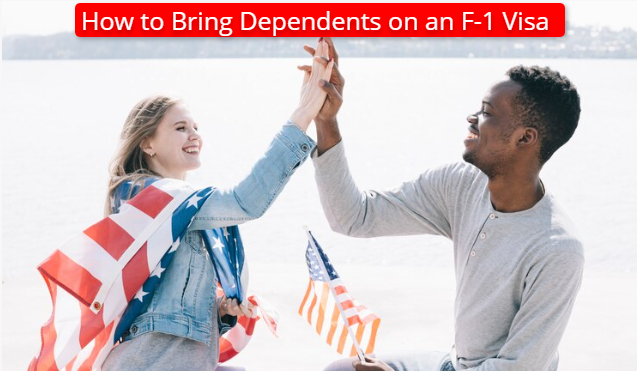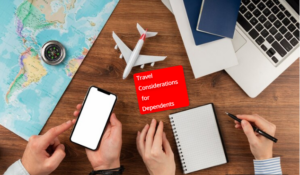How to Bring Dependents on an F-1 Visa: A Detailed Guide

F-1 visa is a gateway for international students seeking higher education in the United States. Many students, however, want to bring their families along for their studies. Dependents—including a spouse or unmarried children under 21—can travel with the F-1 visa holder on an F-2 visa. This guide offers a detailed overview of the process from understanding F-1 visa requirements to making sure dependents’ application is seamless.
What is an F-1 Visa?
The F-1 visa is a form of education visa designed for international students enrolled in accredited U.S. institutions. Candidates have to meet multiple requirements for an F-1 visa, including showing financial capability and enrolling in a full-time academic program.
Those dependents of F-1 visa holders are eligible to apply for an F-2 visa, which allows them to stay in the United States while the primary visa holder pursues their studies.
Step 1: Meet F-1 Visa Requirements for Bringing Dependents
To bring dependents, be sure you meet these requirements:
- Active F-1 Visa Status: Maintain full-time enrollment in an institution accredited by the Student and Exchange Visitor Program (SEVP).
- Sufficient Financial Resources: Provide your dependents and yourself with evidence of financial support.
Request the Designated School Official (DSO) at your institution to obtain a Form I-20 for each dependent you have.
Step 2: Prepare Documents for the F-2 Visa Application
Dependents have to attend an interview at a U.S. embassy or consulate and apply for an F-2 visa. The checklist here is:
- Dependent’s Form I-20: Issued by the DSO.
- Passport: Valid for six months beyond the intended stay.
- Form DS-160: Completed your online visa application.
- Relationship Proof: Birth certificate for children or marriage certificate for a spouse.
- Financial Documents: Evidence of financial capability to support all family members.
- F-1 Visa Holder’s Documents: Copies of the F-1 holder’s Form I-20, visa, and evidence of SEVIS fee payment.
Step 3: Pay the SEVIS Fee
There is no separate SEVIS fee paid by dependents. Their SEVIS record will link to the primary F-1 visa holder.
Step 4: Schedule and Attend the Visa Interview

Dependents have to attend an in-person interview for the F-2 visa.
- Book an Appointment: Schedule the visa interview with the U.S. Visa Appointed System.
- Prepare for the Interview: Expect questions on the purpose of travel and relationship to the F-1 visa holder.
Provide the necessary paperwork to guarantee completeness and accuracy.
Step 5: Entering the U.S. on an F-2 Visa
Dependents can enter the United States with the F-1 visa holder, or after their arrival, once visa permission is approved. Dependents cannot travel before the primary applicant.
Restrictions for F-2 Visa Holders
- Work Limitations: F-2 visa holders cannot work in the United States.
- Study Restrictions: Spouses may only take non-degree courses, children can attend K–12 schools.
- Status Dependency: The visa status of the dependent is linked to the compliance of the F-1 visa holder with U.S. immigration rules.
Changing an F-2 Visa to an F-1 Visa
Dependents on an F-2 visa could want to continue their education. This requires a change in status to an F-1 visa. The steps consist of:
- Apply to a SEVP-Approved Institution: Make sure it offers a Form I-20.
- File Form I-539: Change your status with the United States Citizenship and Immigration Services (USCIS).
- Pay the SEVIS Fee: Submit payment for the new SEVIS ID.
- Await Approval: Processing times vary, so use early approval.
Maintaining Status for F-1 and F-2 Visas
Holders of both F-1 visas and F-2 visas have to follow U.S. immigration laws:
For F-1 Visa Holders:
- Keep full-time active enrollment.
- Avoid unauthorized work.
- Notify your DSO of address changes.
For F-2 Visa Holders:
- Never work under any conditions.
- Follow study limitations.
- Maintain a valid visa and passport.
Travel Considerations for Dependents

F-1 visa travel restrictions apply to dependents as well as the main applicant. Important points consist of:
- Dependents should carry copies of the I-20 form, visa, and enrollment documentation for the F-1 visa holder.
- Re-entry into the United States is permitted only with valid documentation.
Additional Considerations for Dependents on an F-1 Visa
There are several additional factors to consider when deciding whether to bring dependents to the United States on an F-1 visa to guarantee a successful and stress-free experience. These include health, education, cultural adaptation, and future alterations to visas.
Education for Children on an F-2 Visa
Children of F-1 visa holders are free to attend U.S. public or private schools. Here is how you get ready:
- Research Schools: Search for local schools where your child’s needs are met. Public schools are free, but private institutions might be expensive.
- Enroll Early: School enrollment takes time and calls for records such as verification of residence and vaccination records.
- Address Language Barriers: Look for schools with ESL (English as a Second Language) programs if English is not your child’s first language.
Important Points to Remember
- Dependents on F-2 visas have to always keep valid immigration status, linked to the main F-1 visa holder.
- Any changes to the visa status of the primary applicant, including those related to education or program, have to be reported to the DSO and shown on the records of every dependent.
- Dependent children have to leave the United States when they become 21 unless they change their visa status to something else, such as an F-1 visa.
Common Challenges and Solutions

Financial Proof Issues:
Insufficient financial proof could cause visas to be delayed or denied. Provide sponsored letters or detailed bank statements.
Visa Interview Nervousness:
Stay cool and work through practice interview questions. After the F-1 visa expires, officials mostly confirm your relationship and intention to go back home.
I-20 Delays:
Early requests for dependent Form I-20s from your DSO help to prevent last-minute delays.
Future Transitions: From F-1 Visa to Permanent Residency
Eventually, many international students and their families want to transition from an F-1 visa to permanent residency (green card). The paths are shown below:
- Employment Sponsorship: After graduation, F-1 visa holders might apply for an H-1B work visa. Dependents on F-2 visas might adjust their status once the primary applicant transitions.
- Marriage to a U.S. Citizen: Dependents can petition for permanent status if they are married to a U.S. citizen or permanent resident.
- Family-Based Sponsorship: Under particular visa categories, relatives who are U.S. citizens or permanent residents can sponsor dependents.
Tips for a Smooth Process
- Plan: Starting the process early can help you to prevent delays.
- Communicate with Your DSO: The DSO is a valuable resource for understanding F-1 and F-2 visa requirements.
- Organize Financial Documents: Ensure all proof of funds is clear and sufficient.
- Understand Travel Restrictions: Learn about F-1 visa travel restrictions to effectively schedule travels.
- Consult a Legal Expert: Seek a legal expert for complicated matters; immigration lawyers such as those at Passage Law can provide guidance.
Conclusion: Bringing Your Family to the U.S. on an F-1 Visa

Bringing dependents on an F-1 visa helps you to focus on your education and keeps your family close. Following the advice in this guide and complying with U.S. immigration policies will help to guarantee a smooth procedure for all involved.
CTA: Simplify Your Visa Journey with Passage Law
Are you ready to bring your loved ones to the United States? Visit Passage Law for personalized help with F-1 visa and F-2 visa applications. Contact us right now for a smooth application.
